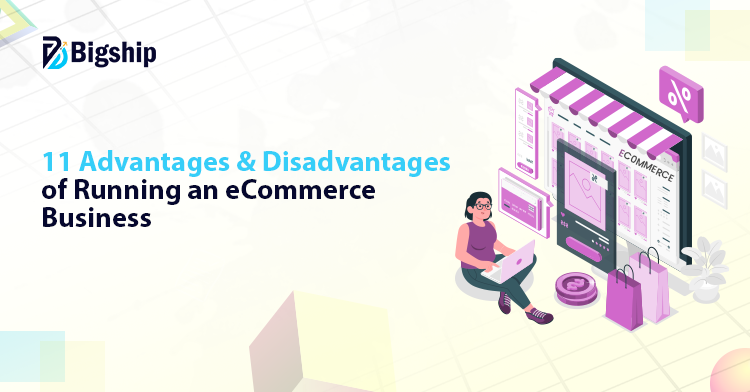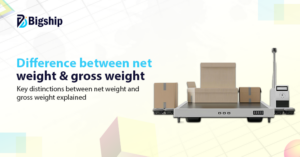In today’s digital world, e-commerce serves the commercial world on a large scale in new markets and gathers customers of all sizes. It is basically the purchasing and selling of goods and services online. This includes using websites, mobile apps, social media, media, and email to facilitate communication between buyers and sellers.

The importance of e-commerce for businesses is undeniable. It offers a vast range of opportunities to grow and succeed. E-commerce gives businesses the tools they need to succeed in the digital world, from lower operating expenses to being open 24/7. However, like any business model, it comes with its own set of challenges, such as cybersecurity threats, technological dependencies, and the complexities of logistics.
In this blog, we’ll explore advantages and disadvantages of e-commerce, helping businesses to decide whether e-commerce is good for them or not.
11 Advantages of e-commerce for Businesses
An e-commerce business comes with several advantages. 11 of these benefits are mentioned below.
1. Wider Market Reach
E-commerce breaks geographical barriers, allowing businesses to reach customers nationally and globally. This extended reach opens up new revenue opportunities far beyond local limits.
2. Reduces Operational Costs
Generally, operating an online store requires minimal staff members and fewer utility expenses, as there is no physical storefront to maintain. The automation systems also require fewer manual interventions, which helps in cost savings.
3. 24/7 Availability
Unlike physical stores, e-commerce platforms operate 24/7. Customers can browse, shop, and place their orders at any time, and businesses can sell more.
4. Data-Driven Insights
One can easily track consumer behavior, sales performance, and traffic sources for online businesses. All these analyses help optimize marketing efforts and work toward creating a personalized client experience.
5. Quick Buying Process
The client shops and checks out in minutes without waiting in queues. In this modern world where everyone is in a hurry, long queues and waiting are a big “no”. This means customers enjoy it more when a purchase is quick, and this translates into better satisfaction and higher conversion rates.
6. Personalized Customer Experience
By employing the strategies of AI and customer segmentation, businesses could carry out personalized recommendations on products as well as advertise promotions, which in turn would increase engagement and loyalty.
7. Scalability
Scaling an e-commerce business requires much less work than scaling a physical store. Product lines can be expanded, new markets can be entered, and marketing efforts can be expanded without actually seeking a new storage location or relocating.
8. Operational Efficiency
An automated system can reduce errors and increase efficiency in everything from inventory management and order completion to customer communication.
9. Globalized Payment, Multiple Currencies
E-commerce supports almost all kinds of payments, digital wallets, UPI, credit cards, and even cryptocurrencies. An international buyer pays in their currency, and this ends up simplifying cross-border trade as well.
10. Eco-Friendly Operations
E-commerce can cut down on carbon footprints for sustainability activities by using digital receipts, online product catalogs, less physical space, and fewer shipments requiring much travel from buyer to seller.
11. Tech Integration in E-commerce
Integrating e-commerce with CRM, inventory, and accounting systems can be complex. But when done correctly, it helps your business save time and money by reducing manual data entry and improving the productivity of your business.
Disadvantages of e-commerce
We already discussed the benefits of e-commerce, however, there are some disadvantages too. Some of the main disadvantages are mentioned below with the solutions to overcome them.
1. Security Risk
The risk of hacking, phishing, and malware attacks grew alongside because of the increase in online transactions. Only one data breach can break the customer trust and henceforth the brand value. E-commerce businesses should implement huge cybersecurity measures, with SSL certificates, encryption, firewalls, and educate employees to follow online safety protocols.
2. Overdependence on Technology
Everything in India depends on technology, including online payments, hosting services, and web development tools. Any small glitch or downtime in the operating system would immediately stop business activities and thereby cause revenue losses. All these require updating with the latest trends and updates, which can be costly and time-consuming at the same time. Backup systems should be in place with IT support.
3. Increased Competition
India’s growing e-commerce market is attracting more businesses, which must compete with many online retailers, including players as well as new startups. It is harder to stand out. To be able to stand in the league, marketing should be intelligent, with selective advertising on well-deserved channels, along with strong customer experience strategies.
4. Customer Service Challenges
In the absence of any kind of in-store assistance, customers may find navigation, payment, or delivery issues. Poor service invites complaints and negative reviews. One should invest in intuitive, user-friendly UIs, efficient logistics, and responsive customer support.
5. Lack of Physical Interactions
Unlike traditional retail, e-commerce has the drawback of not interacting face-to-face to engage its customers, and since online businesses don’t have this advantage, building bonds and establishing trust may be more challenging. Social media, live chat, and customized emails are a few ways to bridge that gap.
6. Shipping & Handling Problems
Shipping in India is complicated because of the vast geographic area, infrastructural issues, and regulatory challenges. The key lies in partnering with a strong logistics service provider and in optimizing the supply chain operation and providing real-time updates to the customers.
7. Trust Building Takes Time
New or lesser-known e-commerce brands first face a stage of suspicion. Customers who hesitate to share personal information and make payments may be at odds with this behavior. Building trust goes a long way when the brand focuses on secure payment options, transparent product information, genuine reviews, and responsive customer service.
8. Limited Sensory Experience
Customers cannot touch, smell, or try products before buying. This can be a drawback for food, clothing, and cosmetics businesses. E-commerce platforms can showcase high-quality images and videos, user reviews and ratings, and offer return policies. Also, if they give trial packs, it can help to increase the interest of customers and build trust and loyalty.
9. No Product Inspection Before Purchase
Customers in India cannot inspect products before purchase. For high-value items, a lack of physical inspection can make customers hesitate to buy the product, especially electronics and jewelry. Clear product specifications, multiple-angle images and videos, comparison tools, and generous return policies can help ease buyer concerns and build trust.
10. Legal & Compliance Burdens
There is a drawback in India’s e-commerce as it is governed by strict laws around data protection, taxation, and consumer rights. Non-compliance can lead to fines or legal trouble, which can be challenging for small and medium-sized businesses. E-commerce should invest in legal knowledge and regulate their operations according to tax laws and consumers’ rights in the region they serve. Consulting with legal experts can help them overcome the legal issues and avoid heavy legal penalties.
11. High Initial Investment and Ongoing Maintenance Costs
Launching an e-commerce site in India requires significant investment in website development, tech, marketing, and operations. Ongoing expenses like hosting, updates, and support add up. Strategic budgeting and the use of cost-effective tools as open-source software and cloud-based hosting, can keep expenses manageable.
Conclusion
As the world is becoming increasingly digitized, business owners should know the pros and cons of e-commerce before diving in. While e-commerce offers convenience, flexibility, and broader reach, and also increases customer engagement, it also increases insecurity, fierce competition, and dependency on technology.
The future of e-commerce in India is growing day by day. As there is a rise in internet, more and more people turn to online shopping, and businesses that embrace digital commerce strategies to attract customers and revenue. However, depends on staying updated with emerging trends and delivering seamless customer experiences.
Sign up with Bigship, your trusted logistics partner, that provides smarter, cost-effective deliveries across India for your e-commerce business!





